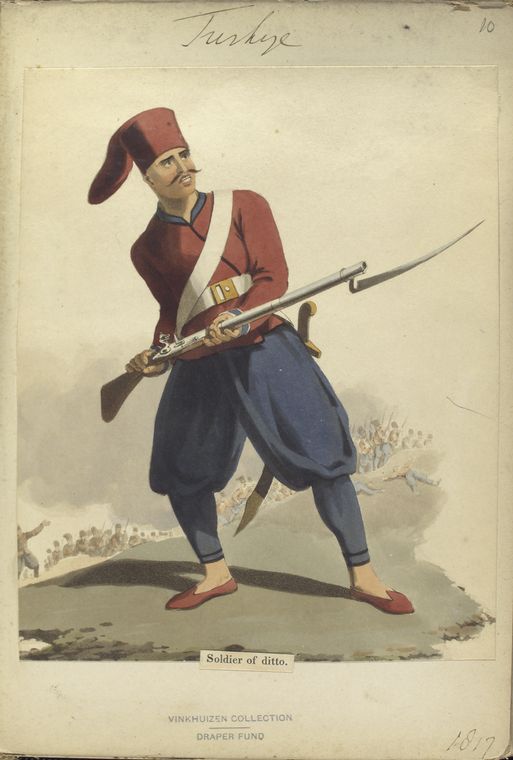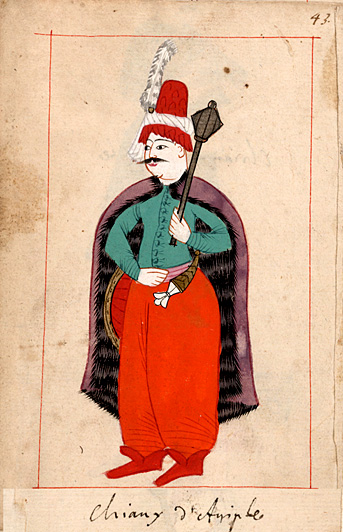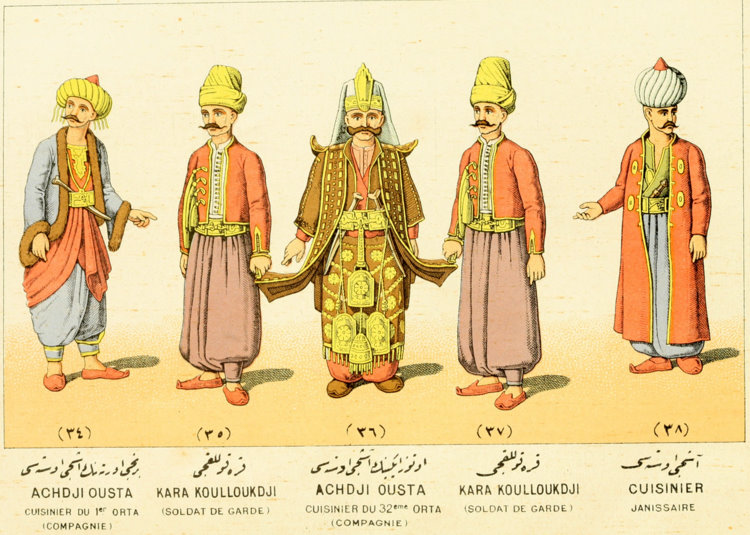I'll repost earlier comments before continuing:
Since Dec 2013: Hans Weigel has been credited; Bimbascha & Janitscharen now appear (alongside the earlier missreadings); the NYPL's note on Vinkhuizjen's collection method is included, Jean Brindesi is noted; McLean's The Military Costume of Turkey is noted; and this footnote added:

This
Druzhina
Illustrations of Ottoman Costume & Soldiers
Dr Chris Flaherty's 'Ottoman Uniforms' site is useful.
The stuff on the early period could still do with some work.
On 1600 TILL 1800 JANISSARY CORPS
This picture:

needs a caption as a Janissary by Hans Weigel, 1577
The long white ostrich feather plumes were not invented by Knotel, he based it on a Janissary by Nicolas de Nicolay, 1577
Knotel may have made up the stripes but Ottoman miniatures show also green, red & black. I would have used 'solid colours' rather than "uniform" so as not to give the impression a unit all wore the same colour, unless he can prove they did in the 17th century.•The Janissary Corps Musketeers' buttoned kaftan is painted in various colours, yet was actually a uniform yellow or blue (as can be seen from these original pictures).
Pictures from an Album of Ottoman Soldiers dated 1805 which I wish he could have identified:

have a long s: ſ in the captions.
Bimbascha should be Bimbascha not Bimbalcha.
Janitscharen should be Janitscharen not Janitjcharen.
On the same page there is a link to a Janissary on my Melchior Lorck, 1570-83, site but no mention that Melchior Lorck has a Janissary with an enormous plume
Figure A, as he notes in a footnote, appears in The Costume of Turkey, Illustrated by a Series of Engravings, 1802 as "a Spahi, belonging to one of the Asiatic provinces", so he should do away with
•Figure 'A': is identified specifically as a "SIPAHI TIMARIOTE" [1]. Which appears to identify him as a member of the Household cavalry.
I don't know much about 19th century Ottomans but on this page THE FIRST MODERN OTTOMAN ARMY UNIFORMS 1800 TILL 1826 has this claim:
The Vinkhuizjen Collection is not a primary source. Vinkhuizjen cut pictures out of books which were pasted in albums, losing most of the provenance and most of any text in these books. The dates Vinkhuizjen penciled on these are often the date of publication rather than the date the image represents or the date of the art it is based on. This can vary by decades and centuries.It should be noted, that a print illustration of 1808 Ottoman new army soldier clearly identifies a soldier (which can be dated to 1807-08 by the particular headgear he is wearing), as a "Soldier of the Bostandjees, or Corps from the Sultan's Gardeners" (New York Public Library's Digital Gallery, the Vinkhuizjen Collection). This primary evidence presents a very different picture of the origins of the soldiers in the new army, as part of the Sultan's personnel household.
On the NAPOLEONIC OTTOMAN JANISSARY CORPS UNIFORMS page is this image:

which has been stitched together after Vinkhuizjen cut it into pieces (so he had more pictures).
More effort would be needed to find all Vinkhuizjen's sources.
There is no "print illustration of 1808 Ottoman new army soldier" with that date in the Vinkhuizjen Collection but this plate:

dated 1817 by Vinkhuizjen is the one referred to. Vinkhuizjen has cut the caption "Soldier of ditto" from the contents page of McLean's The Military Costume of Turkey. Without the line that appeared above it – the caption is useless.
This picture on the fantasy Janissary costume page:

may have appeared in 1880-1900 illustrated encyclopaedias, as noted, but it is from Elbicei Atika. Musée des Anciens Costumes Turcs de Constantinople, par Jean Brindesi, 1855. It also appeared on a set of Turkish postcards made in the 1950s.
Since Dec 2013: Hans Weigel has been credited; Bimbascha & Janitscharen now appear (alongside the earlier missreadings); the NYPL's note on Vinkhuizjen's collection method is included, Jean Brindesi is noted; McLean's The Military Costume of Turkey is noted; and this footnote added:
This re-invention implies that Knotel was unaware of the earlier illustrations, but, it is obvious that Knotel's Janissaries are copied, directly or indirectly, from an Ottoman Janissary by Hans Weigel, Janissaire allant à la guerre by Nicolas de Nicolay & a Janissary by Melchior Lorck.[1] The long white ostrich feather plumes were re-invented by Knotel. However, he based it on Nicolas de Nicolay (1577), as well as the Janissary by Melchior Lorck (1570-83). All these early illustrators show this feature –the Janissary with an enormous plume. However, this is more likely a fantasy element included in the illustrations.

This
can be easily discounted as being 'Tanitfar' by comparing the captions of other Janissaries in the same Album of Ottoman Soldiers dated 1805. The boast that these are "put-together for the first time" just means that the captions have been 'photo-shoped' out.•B: Is either: "Ein Janitsar in voller Rüstung"; or, "Ein Tanitfar in voller Rüftung". Translate into 'Tanitfar'= 'Romanian'; and 'in voller Rüftung' = 'in fuller dress'. The implication is that if this is "Janitsar", then this is an actual Ottoman Janissary soldier from 1805, in which case there has been a considerable Europeanization of the Janissary uniform by this date. If however, it is a 'Romanian' provincial soldier, then the costume is more in keeping with the troops from Eastern Europe.
Druzhina
Illustrations of Ottoman Costume & Soldiers
























